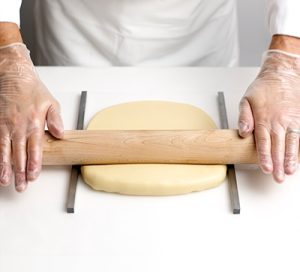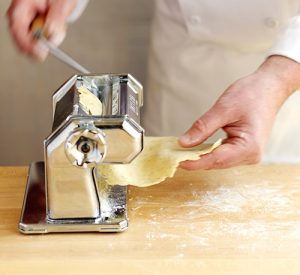To roll pastry dough, lightly dust a cold work surface, the top of the dough, and rolling pin with bench flour (an unmeasured bowl of all-purpose flour used to flour the dough and work surface).
Press the dough from the center, roll it out in one direction, and then roll it out from the center again in another direction. Turn the dough, using a bench scraper to unstick it and dusting the board with bench flour as needed, and roll it from the center again. As the dough is rolled out, it should move on the work surface and not stick to it. Continue until it is the correct size.
For easier rolling: Take one disk out of the refrigerator and roll it out between 2 sheets of lightly floured parchment or waxed paper. Press the dough from the center, then roll it out in one direction and then from the center again in another direction. If the dough sticks to the paper and is difficult to roll out, remove the paper from one side, lightly flour the dough, replace the paper, flip over, lightly flour the other side, then continue rolling. As the dough is rolled out, it should move on the paper and not stick to it.
To ensure evenly rolled dough, use bamboo skewers, which are normally 1/8 inch thick, as gauges on either side of the dough. Place them alongside the dough, not wider than the rolling pin, and roll until the pin rests only on the skewers. You can also purchase reusable guides of any thickness.
 For very thin dough, use a pasta machine. Start by cutting the dough into about 6 oz pieces. Keep the dough not being used in the refrigerator. It is difficult to use if it is not very cold. Place one dough piece on a lightly floured cold surface and dust the top and rolling pin with flour. Roll out into a rectangle about 4 inches wide and 1/4 inch thick so it fits into the pasta machine roller. Re-dust both sides with flour. Run the dough through the pasta machine roller on the widest setting. Adjust the roller to the next thinner setting and run the dough through again. (This is setting 2 on a KitchenAid pasta roller.)
For very thin dough, use a pasta machine. Start by cutting the dough into about 6 oz pieces. Keep the dough not being used in the refrigerator. It is difficult to use if it is not very cold. Place one dough piece on a lightly floured cold surface and dust the top and rolling pin with flour. Roll out into a rectangle about 4 inches wide and 1/4 inch thick so it fits into the pasta machine roller. Re-dust both sides with flour. Run the dough through the pasta machine roller on the widest setting. Adjust the roller to the next thinner setting and run the dough through again. (This is setting 2 on a KitchenAid pasta roller.)


